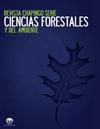Root growth of Taxodium mucronatum Ten. planted in an urban area
IF 0.6
4区 农林科学
Q3 Agricultural and Biological Sciences
Revista Chapingo Serie Ciencias Forestales Y Del Ambiente
Pub Date : 2020-12-01
DOI:10.5154/r.rchscfa.2019.08.064
引用次数: 0
Abstract
Introduction: The ahuehuete (Taxodium mucronatum Ten.), National Tree of Mexico, is frequently found in urban green areas, in conditions of restricted humidity and compacted soils. These characteristics negatively affect growth and survival. Objective: To evaluate root growth of young ahuehuete trees by the effect of the frequency of irrigation and loosening of the soil surrounding the planting strain. Materials and methods: 24 trees 2 m high were planted in an urban area. The experiment was established as a completely random design with factorial arrangement: a) irrigation frequency (frequent [once weekly] and spaced [once every two weeks]) and b) treatment of the soil surrounding the plantation strain (soil with and without loosening). The growth of the root system was monitored for 12 months through digital photographs, obtained from rhizotrons installed on a side wall of each plantation strain. Results and discussion: The original compaction of the site did not present restrictive levels for growth; therefore, the surrounding loosening did not significantly improve (P > 0.1) short-term root growth. Root length (267.75 to 453.28 cm) showed no statistically significant differences for the irrigation and soil factors and their interaction; however, the number of roots was affected by the interaction of the factors (P ≤ 0.1). Trees with frequent irrigation and soil without loosening developed a higher number of roots (190.5). Conclusion: The interaction of irrigation frequency and soil condition influences the number of roots, but not the length.紫紫杉的根系生长。种植在市区的
简介:墨西哥国家树(Taxodium mucronatum Ten.),常见于城市绿地,在湿度受限和土壤压实的条件下。这些特征对生长和生存有负面影响。目的:通过灌水频次和种植品系周围土壤松动程度的影响,评价槐幼树根系生长状况。材料和方法:在市区种植24棵2米高的树木。试验采用全随机因子设计:a)灌溉频率(频繁[每周一次]和间隔[每两周一次])和b)人工林株系周围土壤处理(土壤松动和不松动)。通过安装在每个种植品系侧壁上的根管获得的数字照片,对根系的生长进行了12个月的监测。结果与讨论:该地点的原始压实不存在生长的限制水平;因此,周围松动对短期根系生长没有显著改善(P > 0.1)。根长(267.75 ~ 453.28 cm)在灌溉和土壤因素及其交互作用下无显著差异;根数受各因子交互作用的影响(P≤0.1)。经常灌溉和土壤不松动的树木根系数量较多(190.5)。结论:灌溉频率和土壤条件的交互作用对根的数量有影响,但对根的长度没有影响。
本文章由计算机程序翻译,如有差异,请以英文原文为准。
求助全文
约1分钟内获得全文
求助全文
来源期刊
CiteScore
1.20
自引率
16.70%
发文量
0
审稿时长
>12 weeks
期刊介绍:
The Revista Chapingo Serie Ciencias Forestales y del Ambiente (RCHSCFA) is a scientific journal that aims to raise awareness of high-quality research products related to forest, arid, temperate and tropical environments in the world. Since its foundation in 1994, the RCHSCFA has served as a space for scientific dissemination and discussion at a national and international level among academics, researchers, undergraduate and graduate students, forest managers and public/private entities that are interested in the forest environment.
All content published in the journal first goes through a strict triple-blind review process and is published in the following formats: Scientific Articles, Review Articles, Methodologies, Technical or Technological Notes.

 求助内容:
求助内容: 应助结果提醒方式:
应助结果提醒方式:


